The IB Diploma Programme Course Companions are designed to support students throughout their two-year Diploma Programme. They will help students gain an understanding of what is expected from their subject studies while presenting content in a way that illustrates the purpose and aims of the IB. They reflect the philosophy and approach of the IB and encourage a deep understanding of each subject by making connections to wider issues and providing opportunities for critical thinking.
The books mirror the IB philosophy of viewing the curriculum in terms of a whole-course approach and include support for international minded ness, the IB learner profile and the IB Diploma Programme core requirements, theory of knowledge, the extended essay and creativity, activity, service (CAS).
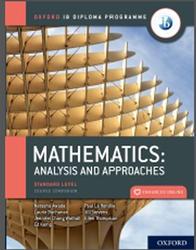
From patterns to generalizations: sequences and series.
The diagrams shown here are the first four iterations of a fractal called the Koch snowflake.
What do you notice about:
• how each pattern is created from the previous one?
• the perimeter as you move from the first iteration through the fourth iteration? How is it changing?
• the area enclosed as you move from the first iteration to the fourth iteration? How is it changing?
What changes would you expect in the fifth iteration? How would you measure the perimeter at the fifth iteration if the original triangle had sides of 1 m in length?
If this process continues forever, how can an infinite perimeter enclose a finite area?
Contents.
Introduction.
How to use your enhanced online course book.
1. From patterns to generalizations: sequences and series.
1.1. Number patterns and sigma notation.
1.2. Arithmetic and geometric sequences.
1.3. Arithmetic and geometric series.
1.4. Applications of arithmetic and geometric.
1.5. The binomial theorem.
1.6. Proofs.
Chapter review.
Modelling and investigation activity.
2. Representing relationships: introducing functions.
2.1. What is a function?.
2.2. Functional notation.
2.3. Drawing graphs of functions.
2.4. The domain and range of a function.
2.5. Composite functions.
2.6. Inverse functions.
Chapter review.
Modelling and investigation activity.
3. Modelling relationships: linear and quadratic functions.
3.1. Gradient of a linear function.
3.2. Linear functions.
3.3. Transformations of functions.
3.4. Graphing quadratic functions.
3.5. Solving quadratic equations by factorization and completing the square.
3.6. The quadratic formula and the discriminant.
3.2. Applications of quadratics.
Chapter review.
Modelling and investigation activity.
4. Equivalent representations: rational functions.
4.1. The reciprocal function.
4.2. Transforming the reciprocal function.
4.3. Rational functions of the form f(x)=ax+b/cx+d
Chapter review.
Modelling and investigation activity.
5. Measuring change: differentiation.
5.1. Limits and convergence.
5.2. The derivative function.
5.3. Differentiation rules.
5.4. Graphical interpretation of first and second derivatives.
5.5. Application of differential calculus: optimization and kinematics.
Chapter review.
Modelling and investigation activity.
6. Representing data: statistics for univariate data.
6.1. Sampling.
6.2. Presentation of data.
8.3. Measures of central tendency.
6.4. Measures of dispersion.
Chapter review.
Modelling and investigation activity.
7 Modelling relationships between two data sets: statistics for bivariate.
7.1 Scatter diagrams.
7.2. Measuring correlation.
7.3. The line of best fit.
7.4. Least squares regression.
Chapter review.
Modelling and investigation activity.
8. Quantifying randomness: probability.
8.1. Theoretical and experimental probability.
8.2. Representing probabilities: Venn diagrams and sample spaces.
8.3. Independent and dependent events and conditional probability.
8.4. Probability tree diagrams.
Chapter review.
Modelling and investigation activity.
9. Representing equivalent quantities: exponentials and logarithms.
9.1. Exponents.
9.2. Logarithms.
9.3. Derivatives of exponential functions and the natural logarithmic function.
Chapter review.
Modelling and investigation activity.
10. From approximation to generalization: integration.
10.1. Antiderivatives and the indefinite integral.
10.2. More on indefinite integrals.
10.3. Area and definite integrals.
10.4. Fundamental theorem of calculus.
10.5. Area between two curves.
Chapter review.
Modelling and investigation activity.
11. Relationships in space: geometry and trigonometry in 2D and 3D.
11.1. The geometry of 3D shapes.
11.2. Right-angled triangle trigonometry.
11.3. The sine rule.
11.4. The cosine rule.
11.5. Applications of right and non-right-angled trigonometry.
Chapter review.
Modelling and investigation activity.
12. Periodic relationships: trigonometric functions.
12.1. Radian measure, arcs, sectors and segments.
12.2. Trigonometric ratios in the unit circle.
12.3. Trigonometric identities and equations.
12.4. Trigonometric functions.
Chapter review.
Modelling and investigation activity.
13. Modelling change: more calculus.
13.1. Derivatives with sine and cosine.
13.2. Applications of derivatives.
13.3. Integration with sine, cosine and substitution.
13.4. Kinematics and accumulating change.
Chapter review.
Modelling and investigation activity.
14 Valid comparisons and informed decisions: probability distributions.
14.1. Random variables.
14.2. The binomial distribution.
14.3. The normal distribution.
Chapter review.
Modelling and investigation activity.
15 Exploration.
Practice exam paper 1.
Practice exam paper 2.
Answers.
Index.
Бесплатно скачать электронную книгу в удобном формате, смотреть и читать:
Скачать книгу Mathematics, Analysis and approaches, Awada N. - fileskachat.com, быстрое и бесплатное скачивание.
Скачать pdf
Ниже можно купить эту книгу, если она есть в продаже, и похожие книги по лучшей цене со скидкой с доставкой по всей России.Купить книги
Скачать - pdf - Яндекс.Диск.
Дата публикации:
Теги: учебник по английскому языку :: английский язык :: Awada
Смотрите также учебники, книги и учебные материалы:
Следующие учебники и книги:
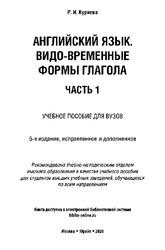 Английский язык, Видо-временные формы глаголов, часть 1, Куряева Р.И., 2020 — Издание состоит из двух частей. В первой части представлена теория по грамматике английского глагола. В сжатой форме рассматриваются все видо-временные … Книги по английскому языку
Английский язык, Видо-временные формы глаголов, часть 1, Куряева Р.И., 2020 — Издание состоит из двух частей. В первой части представлена теория по грамматике английского глагола. В сжатой форме рассматриваются все видо-временные … Книги по английскому языку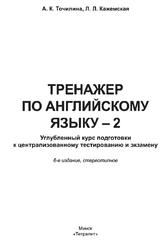 Тренажер по английскому языку-2, Углубленный курс подготовки к централизованному тестированию и экзамену, Топилина А.К., Кажемская Л.Л., 2018 — Пособие предназначено для углубленной подготовки к централизованному тестированию по английскому языку. Включает расширенный грамматический материал, тренировочные и контрольные упражнения, а … Книги по английскому языку
Тренажер по английскому языку-2, Углубленный курс подготовки к централизованному тестированию и экзамену, Топилина А.К., Кажемская Л.Л., 2018 — Пособие предназначено для углубленной подготовки к централизованному тестированию по английскому языку. Включает расширенный грамматический материал, тренировочные и контрольные упражнения, а … Книги по английскому языку Английский для всех, Почему нет, учебное пособие, Лысенко А.Н., Кульчицкая О.И., Кульчицкая Н.А., 2011 — Учебное пособие предназначено в первую очередь для студентов языковых вузов, аспирантов и всех желающих углубить и расширить свои знания, развить … Книги по английскому языку
Английский для всех, Почему нет, учебное пособие, Лысенко А.Н., Кульчицкая О.И., Кульчицкая Н.А., 2011 — Учебное пособие предназначено в первую очередь для студентов языковых вузов, аспирантов и всех желающих углубить и расширить свои знания, развить … Книги по английскому языку Все времена английского языка за час, Наглядный самоучитель, Трофименко Т., 2015 — Татьяна Трофименко преподаватель, автор бестселлера 505 самых важных английских фраз , создатель собственной оригинальной методики, основанной на едином принципе построения … Книги по английскому языку
Все времена английского языка за час, Наглядный самоучитель, Трофименко Т., 2015 — Татьяна Трофименко преподаватель, автор бестселлера 505 самых важных английских фраз , создатель собственной оригинальной методики, основанной на едином принципе построения … Книги по английскому языку
Предыдущие статьи:
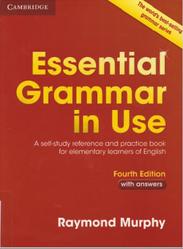 Essential Grammar in Use, Murphy R., 2015 — This is a grammar book for elementary students of English. There are 115 units in the book and each unit … Книги по английскому языку
Essential Grammar in Use, Murphy R., 2015 — This is a grammar book for elementary students of English. There are 115 units in the book and each unit … Книги по английскому языку Эффективная память, Как быстро запоминать цифры и английские слова, Матюгин И.Ю., 2005 — В книге даются наиболее эффективные методы запоминания цифр и английских слов. Ранее эти методы были известны лишь узкому кругу специалистов, … Книги по английскому языку
Эффективная память, Как быстро запоминать цифры и английские слова, Матюгин И.Ю., 2005 — В книге даются наиболее эффективные методы запоминания цифр и английских слов. Ранее эти методы были известны лишь узкому кругу специалистов, … Книги по английскому языку Эти незнакомые знакомые английские слова, О неизвестных значениях 50 известных слов, Хейнонен Е., 2015 — Цель книги в доступной форме рассказать о значениях простых и распространенных английских слов. Освоив их, изучающие английский уберегут себя от … Книги по английскому языку
Эти незнакомые знакомые английские слова, О неизвестных значениях 50 известных слов, Хейнонен Е., 2015 — Цель книги в доступной форме рассказать о значениях простых и распространенных английских слов. Освоив их, изучающие английский уберегут себя от … Книги по английскому языку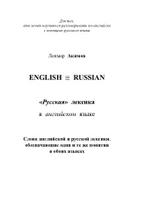 Русская лексика в английском языке, Акимов Л. — Настоящая публикация содержит однокоренные слова с одинаковым смысловым содержанием, входящие в состав лексики как родного для нас русского, так и … Книги по английскому языку
Русская лексика в английском языке, Акимов Л. — Настоящая публикация содержит однокоренные слова с одинаковым смысловым содержанием, входящие в состав лексики как родного для нас русского, так и … Книги по английскому языку




